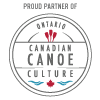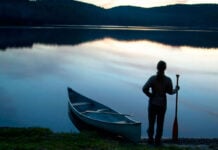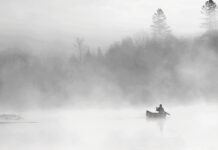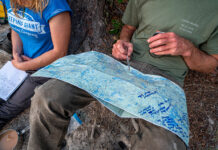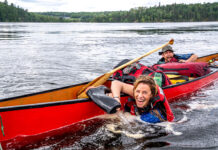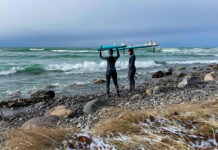On a recent Sunday evening, I was paddling a lazy river. The sky was glowing pink, the cattails golden and dancing in the evening breeze. My only company were a dozen three-foot-long salmon leaping from the water. As the river narrowed, I startled a beaver on the shore. The water was clear, with just one shallow channel deep enough for travel. The beaver dove and for a hundred meters he swam alongside the canoe. He was close enough I could have reached over the gunwale and stroked his back.
It was a little slice of paradise. I could have been anywhere, but I was close enough to portage home.
The belief in the healing powers of green spaces has existed for at least 2,500 years, since Cyrus the Great built gardens for relaxation in Persia’s ancient capital. As the effect of nature on the brain has been increasingly studied, countless reports have touted the benefits. From lowered blood pressure and stress levels, to increased contentment and creativity—logging time outside has even been linked to easing symptoms of ADHD, addiction and depression.
For nature lovers, this isn’t surprising. What is surprising is that most of these studies don’t take place in wilderness or even semi-wilderness areas. In fact, most take place in the green spaces local to the urban centers where 80 percent of the North American population lives. Even just a five-minute walk in a leafy city park can improve mood by boosting the production of all natural, feel-good chemicals in the brain, according to the journal of Environmental Health and Technology.
Most canoeists intuitively believe that the longer the trip and the more remote the location, the more positive benefits bestowed on the psyche. I partly agree. But the research is also clear: you don’t have to go far to find happiness. Your own backyard offers plenty.

I split my time between Canoeroots’ riverside rural headquarters and a home office in a city of 2.6 million. While kayakers and paddleboarders seem to embrace the notion of day-trips on urban streams, rivers and lakes, canoeists are far less common. I see canoes strapped to roof racks on the highways heading out of town, but in the city, it’s kayaks and paddleboards to canoes 20:1. Perhaps, because we associate the canoe so closely with wilderness experiences, it seems like an unlikely craft for shorter excursions.
In that case, we are missing out.
“Canoeing is like eating,” a friend recently told me. “It’s best done more than once a year.”
Too often, paddlers focus on one or two big trips for the year, gorging themselves for 10 days and then starving the other 354. In comparison to traveling remote glacier-fed mountain rivers, urban paddling sounds boring—but it’s not. Yes, it’s a wondrous experience to paddle where few humans have been before. Yet, I’ve found there’s magic on the quiet waters a stone’s throw from a buzzing metropolis. It’s not any more spectacular, but sometimes—strangely—perhaps more special. Like discovering a secret in a city of millions. For most North Americans, paddling in the urban jungle is the only way to get out on the water more often and reap those intoxicating and all-natural highs. Wilderness trips every weekend aren’t realistic for everyone, but a Sunday afternoon paddle can be.
We canoeists, who pride ourselves on overcoming grueling portages, hordes of blackflies and relentless headwinds on our quest for adventure, shouldn’t let a little concrete get in the way of achieving the greater benefits of being connected with the natural world.
Kaydi Pyette is the former editor of Canoeroots magazine.
